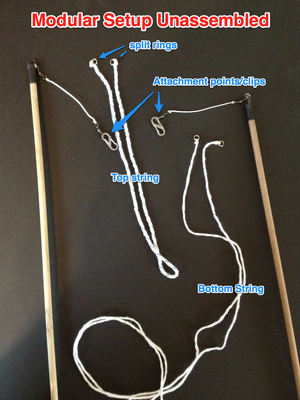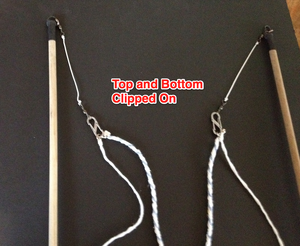Modular Loops[]


Clip the bottom string on to your leads.

Clip the top string to your leads

You are ready to make bubbles!
A modular tri-string loop is a loop whose top and bottom strings independently connected to the wand's clips (attachment points) without being bound together. Modular loops allow you to easily mix and match top and bottom strings on the fly to create composite loops . There seems to be no penalty (downside) for not having the top and bottom bound together.
A modular setup is simple
- Your wand needs a clip of some sort attached to each leader (if you use leaders) or wand tip. This is called the attachment point.
- Each top and bottom string needs a split ring or other loop at each end that will clip onto the wands attachment points.
Clip the bottom string's ends to the attachment points then clip the top string to the attachment points.
See also: Composite Tri-StringLoops
Keepers []
Binding the top and bottom strings.

A keeper can be used to bind the top and bottom strings together. In most cases, this binding is not necessary.
You may temporarily bind the top and bottom together with simple keepers if you prefer to have them bound together. So far, there does not seem to be any benefit to binding them, but some people like to do so.
Benefits[]
A modular setup is especially handy if you are experimenting with composite tri-string loops. In the field, you can swap out bottom strings or top strings. They are also handy for making adjustments in the field for varying conditions. Since the bottom-string so heavily influences the wand's closing characteristics, you may find that when the breeze picks up you want a heavier or lighter bottom string. With a modular setup, you don't need a complete loop for every combination that you would like to use. The top-string is the primary juice carrier and generally does not have much impact on bubble release. So, you can take one top-string and a variety of bottom strings and swap them as necessary.
Doubling Up[]
You can even use multiple bottom or top strings as long as they are the same length. You do not even need to twist them together. If the multiples are made of different materials, you may find that they stretch differently when wet. If this happens, you may want to make an adjustment in the field to make their lengths the same. You can do this with a keeper.
Videos[]
These videos show modular tri-strings in action. Many of the videos on this site were made with modular tri-strings. Most videos and photos by Edward from mid-2012 on were made with modular setups. The videos below were from the period when I was first exploring modular loops.
This video is a bit shaky as the video camera was being held by the person making the bubbles. The video shows a 6' top-string (Rayon Finish Mop Yarn) with two different types of bottom strings (1 and 2 ply mop yarns).
A short video showing the same wand (4-ply rayon mop yarn for the top string and a singly ply for the bottom)

Giant bubble created with a modular loop: 100" full-ply mop string top and 220" single strand bottom (single strand of deconstructed rayon mop yarn)